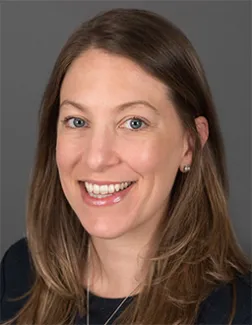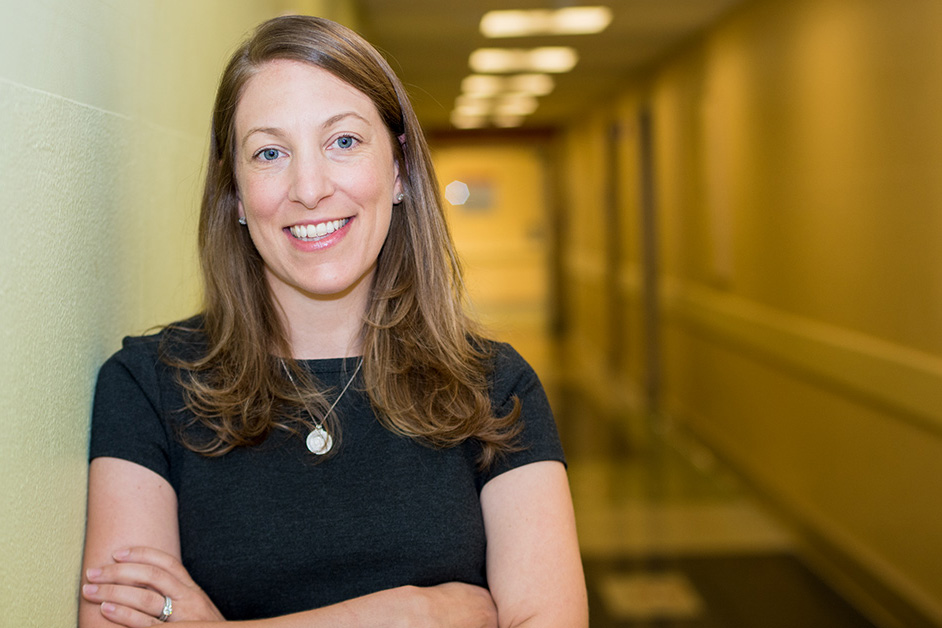

Information
Related Research Units
Research Overview
My research and training to date highlight my commitment to advancing the field of neurosurgery. I graduated from Yale with a B.A. in political science and a focus on neurovascular research. Interested in understanding the molecular biologic basis for cerebrovascular anomalies, I studied the proteins encoded by the 3 genes known to be mutated in familial cerebral cavernous malformations-Krit1, Malcalvernin, and PDCD10 in the Gunel Lab. As a medical student at Stanford University, I studied vascular injury and repair through stem cell homing and recruitment in the Rabinovitch Lab and was then awarded a one-year Howard Hughes Research Fellowship at the NIH to focus on mesenchymal stem cell biology in the Tuan Lab. As a neurosurgery resident at Massachusetts General Hospital, my clinical interest in vascular injury and dysregulation extended beyond primary vascular pathologies to oncologic processes as well.
As a post-doctoral fellow in the Boston Children’s Vascular Biology Program at Harvard, I began formulating my research questions with a focus on bench to bedside translation. Under the mentorship of both Edward Smith, M.D. and Marsha Moses, PhD., I studied urinary biomarkers and discovered a urinary biomarker fingerprint unique to juvenile pilocytic astrocytomas. This non-invasive test serves as a potential adjunct tool for long-term clinical follow in low grade glioma. Under the same mentorship, I have studied the role of axonal guidance factors in congenital pediatric neurovascular disease and have demonstrated contributions to pathologic vascular endothelial dysfunction. This work has been presented on a national level at both the International Stroke Conference as well as the AANS/CNS Pediatric section meetings.
Education
Undergraduate School
Medical School
Internship
Residency
Fellowship
Media
Publications
- The Role of Intraoperative Neurophysiologic Monitoring on Surgical Decision Making and Neurologic Outcomes in Pediatric Patients With Intramedullary Spinal Cord Tumors. J Clin Neurophysiol. 2025 Feb 26. View Abstract
- Clinical utility of DNA methylation profiling for choroid plexus tumors. Neurooncol Adv. 2024 Jan-Dec; 6(1):vdae097. View Abstract
- The disparity in pediatric spinal cord tumor clinical trials: A scoping review of registered clinical trials from 1989 to 2023. Neurooncol Pract. 2024 Oct; 11(5):532-545. View Abstract
- Discovery and Characterization of Ephrin B2 and EphB4 Dysregulation and Novel Mutations in Cerebral Cavernous Malformations: In Vitro and Patient-Derived Evidence of Ephrin-Mediated Endothelial Cell Pathophysiology. Cell Mol Neurobiol. 2023 Dec 27; 44(1):12. View Abstract
- H3K27-altered diffuse midline gliomas with MAPK pathway alterations: Prognostic and therapeutic implications. J Neuropathol Exp Neurol. 2023 12 22; 83(1):30-35. View Abstract
- Management of Choroid Plexus Tumors and the Benefit of Preoperative Embolization in Pediatric Patients: Report of 46 Cases from a Single Institution. World Neurosurg. 2024 01; 181:e1071-e1087. View Abstract
- Mutation of key signaling regulators of cerebrovascular development in vein of Galen malformations. Nat Commun. 2023 11 17; 14(1):7452. View Abstract
- Disease specific urinary biomarkers in the central nervous system. Sci Rep. 2023 11 07; 13(1):19244. View Abstract
- Benefits and limitations of a dual faculty neurosurgeon approach to resection of pediatric craniopharyngioma. Childs Nerv Syst. 2024 Mar; 40(3):647-653. View Abstract
- Use of intraoperative bone scintigraphy for resection of spinal osteoid osteoma. Pediatr Radiol. 2023 11; 53(12):2424-2433. View Abstract
- The evolution of spinal cord surgery: history, people, instruments, and results. Childs Nerv Syst. 2023 10; 39(10):2687-2700. View Abstract
- Single-institution Series of Hirayama Disease in North America. Clin Spine Surg. 2024 02 01; 37(1):9-14. View Abstract
- ALK Amplification and Rearrangements Are Recurrent Targetable Events in Congenital and Adult Glioblastoma. Clin Cancer Res. 2023 07 14; 29(14):2651-2667. View Abstract
- Endoscopic third ventriculostomy with choroid plexus cauterization: predictors of long-term success and comparison with shunt placement for primary treatment of infant hydrocephalus. J Neurosurg Pediatr. 2023 08 01; 32(2):201-213. View Abstract
- Genetic dysregulation of an endothelial Ras signaling network in vein of Galen malformations. bioRxiv. 2023 Mar 21. View Abstract
- Intracranial venous malformation masquerading as a meningioma in PI3KCA-related overgrowth spectrum disorder. Am J Med Genet A. 2022 03; 188(3):907-910. View Abstract
- Predictors of progression in radiation-induced versus nonradiation-induced pediatric meningiomas: a large single-institution surgical experience. J Neurosurg Pediatr. 2021 08 01; 28(2):160-166. View Abstract
- Medulloblastoma in the setting of megalencephaly polymicrogyria polydactyly hydrocephalus. Am J Med Genet A. 2021 05; 185(5):1614-1618. View Abstract
- Single-institution case series of pituitary biopsy for suspected germinoma in the pediatric population: diagnostic utility, operative risks, and biopsy approaches. Sci Rep. 2020 09 17; 10(1):15257. View Abstract
- Low threshold for intracranial imaging in fever of unknown origin associated with cyanotic heart disease in the pediatric population. Childs Nerv Syst. 2021 01; 37(1):335-338. View Abstract
- Complex Management of Hydrocephalus Secondary To Choroid Plexus Hyperplasia. World Neurosurg. 2020 09; 141:101-109. View Abstract
- Mechanisms and therapeutic implications of hypermutation in gliomas. Nature. 2020 04; 580(7804):517-523. View Abstract
- Dysregulation of the EphrinB2-EphB4 ratio in pediatric cerebral arteriovenous malformations is associated with endothelial cell dysfunction in vitro and functions as a novel noninvasive biomarker in patients. Exp Mol Med. 2020 04; 52(4):658-671. View Abstract
- Dynamic mapping of the corticospinal tract in open cordotomy and myelomeningocele surgery. J Clin Neurosci. 2020 Apr; 74:225-231. View Abstract
- Indirect bypass for maternal symptomatic moyamoya in the first trimester of pregnancy: case report. J Neurosurg Pediatr. 2020 02 01; 25(2):138-143. View Abstract
- Microsurgical Ligation of Residual Fistulous Arteriovenous Shunt From a Radicular Artery to a Thoracic Arteriovenous Malformation: 2-Dimensional Operative Video. Oper Neurosurg (Hagerstown). 2019 Nov 01; 17(5):E206-E207. View Abstract
- Dynamic Changes in Arteriovenous Malformations (AVMs): Spontaneous Growth and Resolution of AVM-Associated Aneurysms in Two Pediatric Patients. Pediatr Neurosurg. 2019; 54(6):394-398. View Abstract
- Recovery of Functional Independence After Traumatic Transtentorial Herniation With Duret Hemorrhages. Front Neurol. 2019; 10:1077. View Abstract
- Rare Giant Prevertebral Thoracic Myelomeningocele. World Neurosurg. 2018 Jan; 109:296-297. View Abstract
- Using urinary bFGF and TIMP3 levels to predict the presence of juvenile pilocytic astrocytoma and establish a distinct biomarker signature. J Neurosurg Pediatr. 2016 Oct; 18(4):396-407. View Abstract
- Posterior thoracic laminoplasty with dorsal, intradural identification of ventral defect and transdural discectomy for a spontaneous cerebrospinal fluid leak: case report. J Neurosurg Spine. 2015 May; 22(5):478-82. View Abstract
- Columbia softball charity award 195 urinary biomarkers identify pediatric brain tumors noninvasively and correlate with prognostic risk factors. Neurosurgery. 2014 Aug; 61 Suppl 1:225. View Abstract
- Preconditioning effect on cerebral vasospasm in patients with aneurysmal subarachnoid hemorrhage. Neurosurgery. 2014 Apr; 74(4):351-8; discussion 358-9. View Abstract
- Whole brain radiation therapy (WBRT) alone versus WBRT and radiosurgery for the treatment of brain metastases. Cochrane Database Syst Rev. 2012 Sep 12; (9):CD006121. View Abstract
- Successful repair of a gunshot wound to the head with retained bullet in the torcular herophili. World Neurosurg. 2011 Sep-Oct; 76(3-4):362.e1-4. View Abstract
- Langerhans cell histiocytosis in a 5-month-old presenting with biparietal masses. J Neurosurg Pediatr. 2010 Oct; 6(4):393-7. View Abstract
- Whole brain radiation therapy (WBRT) alone versus WBRT and radiosurgery for the treatment of brain metastases. Cochrane Database Syst Rev. 2010 Jun 16; (6):CD006121. View Abstract
- Stealth surgery: subcutaneous endoscopic excision of benign lesions of the trunk and lower extremity. J Pediatr Surg. 2010 Apr; 45(4):840-4. View Abstract
- Interleukin-6 maintains bone marrow-derived mesenchymal stem cell stemness by an ERK1/2-dependent mechanism. J Cell Biochem. 2009 Oct 15; 108(3):577-88. View Abstract
- PDCD10, the gene mutated in cerebral cavernous malformation 3, is expressed in the neurovascular unit. Neurosurgery. 2008 Apr; 62(4):930-8; discussion 938. View Abstract
- Reactivation of gammaHV68 induces neointimal lesions in pulmonary arteries of S100A4/Mts1-overexpressing mice in association with degradation of elastin. Am J Physiol Lung Cell Mol Physiol. 2008 Feb; 294(2):L276-89. View Abstract
- CCM2 expression parallels that of CCM1. Stroke. 2006 Feb; 37(2):518-23. View Abstract
- Mutations in apoptosis-related gene, PDCD10, cause cerebral cavernous malformation 3. Neurosurgery. 2005 Nov; 57(5):1008-13. View Abstract
- Cerebral venous malformations have distinct genetic origin from cerebral cavernous malformations. Stroke. 2005 Nov; 36(11):2479-80. View Abstract




